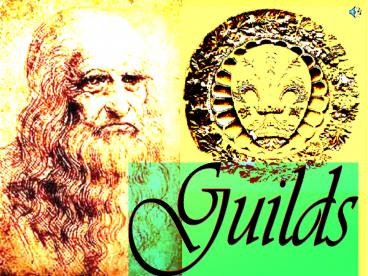Guilds - PowerPoint PPT Presentation
Title:
Guilds
Description:
Title: PowerPoint Presentation Author: Tiffany Liu Last modified by: JW Created Date: 1/27/2005 4:47:56 AM Document presentation format: On-screen Show – PowerPoint PPT presentation
Number of Views:268
Avg rating:3.0/5.0
Title: Guilds
1
Guilds
2
Origins of Italian Guilds
- Roman collegia
- Most likely preserved in fall of Rome
- Mercanzia in 10th century mother guild
3
Role of the Guilds
- Monopoly economic power
- Guardians of knowledge
- Provided social structure and managerial support
eg. wages, terms of sale, contract making etc. - Participated in government
4
Changes During the Renaissance
- Renaissance a period of decline for guilds
- Expanding power of the state
- Expanding markets (growth of aristocracy)
5
Arti Maggiori (Greater Guilds)
- Arte di Calimala (Wool/Import Merchants)
- Arte della Lana (Woolworkers)
- Arte del Cambio (Bankers)
- Arte dei Giudici e Notai (Judges and Notaries)
- Arte della Seta (Silk Weavers/Goldsmiths)
- Arte dei Medici e Speziali (Physicians and
Pharmacists) - Arte dei Vaiai e Pellicciai (Furriers)
6
Arti Minori (Minor Guilds)
- Butchers
- Shoe Makers
- Tavern Keepers
- Tanners
- Salt and Cheese
- Harness Makers
- Masons
- Bakers
- Blacksmiths
- Carpenters
- Hotel Keepers
- Oil Merchants
- Linen Manufacturers
- Armor Makers
- Locksmiths
7
- Members of the Greater Guilds were called popolo
grasso (fat people) - Members of the Minor Guilds were called popolo
minuto (little people)
8
The Baptism of Christ by Andrea del Verrocchio
(angels painted by da Vinci)
9
Guilds for Artists
- Medici e Speziali (Physicians and Pharmacists) -
for painters - Arte de Pietra e Legname (Carpenters, Stone and
Woodworkers) - for sculptors - Arte Della Seta (Silk Weavers) for bronze
sculptors
10
Patronage
11
Leonardo da Vinci's The Last Supper,
commissioned by his patron Duke Ludovico Sforza
and painted in the refectory of the convent of
Santa Maria delle Grazie in Milan
12
One of da Vincis designs for an ornithopter,
designed while the maestro worked for Ludovico
Sforza
13
Detail of God, from Michelangelos fresco on the
ceiling of the Sistine Chapel, commissioned by
Pope Julius II
14
Orsanmichele
15
- 1. Giambologna, St. Luke, marble
- 2. Verrocchio, Doubting Thomas, bronze
- 3. Ghiberti, St. John the Baptist, bronze
- 4. St. John the Evangelist
- 5. Simone di Ferruci, Virgin and Child, marble
- 6. St. James, marble
- 7. Donatello, St. Mark, marble
- 8. Nanni di Banco, St. Eligius, marble
- 9. Ghiberti, St. Stephen, bronze
- 10. Ghiberti, St. Matthew, bronze
- 11. Donatello, St. George, marble
- 12. Nanni di Banco, Quattro Coronati, marble
- 13. Nanni di Banco, St. Phillip,
- marble
- 14. Ciuffagni, St. Peter, marble
16
Organization and Development of Guilds
- Each guild established rules of behavior and
quality for their members. - Members of guilds had full benefits of
citizenship. - Despite comprising only a small percent of the
population, guilds held all the power. - One needed to belong to a guild in order to run
for a political office.
17
Power of the Artists
- Power was not based on individual capacities
- Power was only gained when individuals were
willing to join together and work as a
collective. - Only masters in the trade would generally be
allowed to sell the product or to employ others
to produce. - The need to work in groups hindered the
creativity of many authors. Keep in mind the ego
of Brunelleschi
18
Spread of knowledge and creativity
- It was required that gentlemen be involved in one
of the seven liberal arts Grammar, logic, music,
rhetoric, arithmetic, geometry or astronomy. - Each guild set the terms of its craft forms of
labor, standards of product and method of sale.
Much cooperation was necessary. - Guilds became increasingly rigid as time
progressed. - Thus, the development of the new trade and
industry fell to the capitalists.
19
Continued
- All artists spent their youth as apprentices
learning the craft in their masters workshop. - Artists occasionally attempted masterpieces.
- This piece had to be recognized by their guild in
order for them to become a master artist. - Only after this process was an artist allowed to
open their own workshop.
20
Continued
- Guilds tried to control every aspect of the
creative process. - Artists who may have been geniuses were
constrained to these rules but could not have
been successful independently. - In fact, Brunelleschi attempted to break from his
guild in 1434 but was subsequently thrown in
prison. - Brunelleschi was not the first but the countless
attempts to break free from guilds caused a new
era of independent artists.
21
Weakness of the Guilds
- Guilds were unable to adjust to the technological
process of their times. - Members could not use a new method of
manufacturing unless it was accepted by the guild
and provided for in regulations. - This process proved to be nearly impossible.
Those who were the actual inventors of the
process were forced to work outside of the
guilds, without safety and without guaranteed
success.
22
Fine

